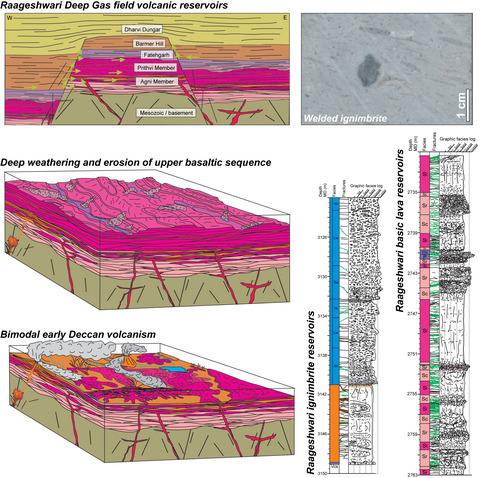当前位置:
X-MOL 学术
›
Basin Res.
›
论文详情
Our official English website, www.x-mol.net, welcomes your feedback! (Note: you will need to create a separate account there.)
Volcanic facies architecture of early bimodal volcanism of the NW Deccan Traps: Volcanic reservoirs of the Raageshwari Deep Gas Field, Barmer Basin, India
Basin Research ( IF 3.2 ) Pub Date : 2021-08-26 , DOI: 10.1111/bre.12605 John M. Millett 1, 2 , Dougal A. Jerram 3, 4 , Sverre Planke 1, 4 , Bineet K. Mund 5 , Shubhodip Konar 5 , Ruchika Sharda 5 , Dwarika Maharjan 1 , Tanzeem Patankar 5
Basin Research ( IF 3.2 ) Pub Date : 2021-08-26 , DOI: 10.1111/bre.12605 John M. Millett 1, 2 , Dougal A. Jerram 3, 4 , Sverre Planke 1, 4 , Bineet K. Mund 5 , Shubhodip Konar 5 , Ruchika Sharda 5 , Dwarika Maharjan 1 , Tanzeem Patankar 5
Affiliation

|
The Deccan Traps large igneous province (LIP) comprises one of the largest continental flood basalt provinces on Earth with the main phase of volcanism spanning the Cretaceous-Palaeogene boundary. The oldest volcanism of the province is encountered in the northwest of modern-day India where Deccan stratigraphy is often buried beneath thick Cenozoic sedimentary sequences. The Raageshwari Deep Gas (RDG) Field, located onshore in the central Barmer Basin, NW India, produces gas from the early Deccan Raageshwari Volcanics which are subdivided into two members, the Agni Member and the overlying Prithvi Member. The RDG comprises a globally important example of a producing volcanic reservoir whilst also offering unique insights into the early volcanism of the Deccan with the aid of extensive high quality sub-surface data. Within this study, the volcanic facies of the RDG sequences are investigated from five cored intervals (total 160 m). Core-based facies determinations are compared with geochemical analyses, petrophysical analyses of the cores (density, porosity and permeability), and wireline data including micro-resistivity borehole images (FMI) and Nuclear Magnetic Resonance (NMR) data. A wireline based volcanic lithofacies scheme is developed and applied to the uncored parts of the sequence which in turn is compared to 3D seismic data. Results of the study reveal the Agni Member to comprise a compositionally bimodal (basalt through to trachyte), dominantly alkaline series with mixed volcanic facies including spectacular felsic ignimbrites, basic-intermediate simple lava flows, volcaniclastic units and newly identified shallow intrusions. The Prithvi Member in contrast is dominated by tholeiitic basalt compositions with less common basic-intermediate alkaline compositions and comprises a sequence dominated by classic tabular lava flow facies inter-digitated with boles, volcaniclastic units, rare compound braided lava facies and evolved tuffaceous ash layers. In one interval of the Prithvi Member, evidence for agglutinated spatter is recorded inferring potential proximity to a palaeo-eruption site within the area. Comparison between core data and volcanic facies reveals a first order control of volcanic facies on reservoir properties highlighting the importance of volcanic facies appraisal in the development of volcanic reservoirs.
中文翻译:

西北德干圈闭早期双峰火山作用的火山相结构:印度巴尔默盆地 Raageshwari 深气田的火山储层
德干圈闭大型火成岩省 (LIP) 是地球上最大的大陆洪水玄武岩省之一,火山作用的主要阶段跨越白垩纪-古近纪边界。该省最古老的火山活动发生在现代印度的西北部,那里的德干地层经常被埋在厚厚的新生代沉积层序之下。Raageshwari Deep Gas (RDG) 气田位于印度西北部 Barmer 盆地中部的陆上,从早期的 Deccan Raageshwari 火山中生产天然气,该火山分为两个部分,Agni 段和上覆的 Prithvi 段。RDG 包括一个全球重要的生产火山储层的例子,同时还借助广泛的高质量地下数据提供对德干早期火山活动的独特见解。在这项研究中,从五个取芯层段(共 160 m)研究了 RDG 层序的火山相。将基于岩心的相确定与地球化学分析、岩心的岩石物理分析(密度、孔隙度和渗透率)以及包括微电阻率钻孔图像 (FMI) 和核磁共振 (NMR) 数据在内的电缆数据进行比较。开发了一种基于电缆的火山岩相方案,并将其应用于层序的未取芯部分,进而与 3D 地震数据进行比较。研究结果表明 Agni 段包含一个成分双峰(玄武岩到粗面岩),主要为碱性系列,混合火山相,包括壮观的长英英熔凝灰岩、碱性-中级简单熔岩流、火山碎屑单元和新发现的浅层侵入体。相比之下,Prithvi 段以拉斑玄武岩成分为主,碱性-中碱性成分较少,包括一个以经典板状熔岩流相为主的层序,与岩浆、火山碎屑单元、罕见的复合辫状熔岩相和演化凝灰质灰层相互交叉。在 Prithvi Member 的一个间隔中,记录了凝集飞溅的证据,推断可能靠近该地区的一个古火山喷发地点。岩心数据与火山相的比较揭示了火山相对储层性质的一级控制,突出了火山相评价在火山岩储层开发中的重要性。
更新日期:2021-08-26
中文翻译:

西北德干圈闭早期双峰火山作用的火山相结构:印度巴尔默盆地 Raageshwari 深气田的火山储层
德干圈闭大型火成岩省 (LIP) 是地球上最大的大陆洪水玄武岩省之一,火山作用的主要阶段跨越白垩纪-古近纪边界。该省最古老的火山活动发生在现代印度的西北部,那里的德干地层经常被埋在厚厚的新生代沉积层序之下。Raageshwari Deep Gas (RDG) 气田位于印度西北部 Barmer 盆地中部的陆上,从早期的 Deccan Raageshwari 火山中生产天然气,该火山分为两个部分,Agni 段和上覆的 Prithvi 段。RDG 包括一个全球重要的生产火山储层的例子,同时还借助广泛的高质量地下数据提供对德干早期火山活动的独特见解。在这项研究中,从五个取芯层段(共 160 m)研究了 RDG 层序的火山相。将基于岩心的相确定与地球化学分析、岩心的岩石物理分析(密度、孔隙度和渗透率)以及包括微电阻率钻孔图像 (FMI) 和核磁共振 (NMR) 数据在内的电缆数据进行比较。开发了一种基于电缆的火山岩相方案,并将其应用于层序的未取芯部分,进而与 3D 地震数据进行比较。研究结果表明 Agni 段包含一个成分双峰(玄武岩到粗面岩),主要为碱性系列,混合火山相,包括壮观的长英英熔凝灰岩、碱性-中级简单熔岩流、火山碎屑单元和新发现的浅层侵入体。相比之下,Prithvi 段以拉斑玄武岩成分为主,碱性-中碱性成分较少,包括一个以经典板状熔岩流相为主的层序,与岩浆、火山碎屑单元、罕见的复合辫状熔岩相和演化凝灰质灰层相互交叉。在 Prithvi Member 的一个间隔中,记录了凝集飞溅的证据,推断可能靠近该地区的一个古火山喷发地点。岩心数据与火山相的比较揭示了火山相对储层性质的一级控制,突出了火山相评价在火山岩储层开发中的重要性。



























 京公网安备 11010802027423号
京公网安备 11010802027423号